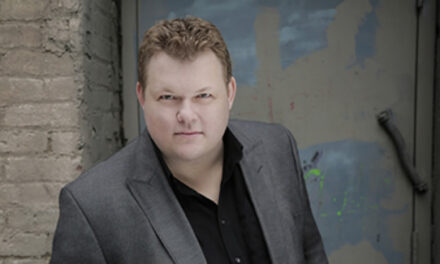The fourth and final event of Raleigh’s First Annual Paderewski Festival, held in the North Carolina Museum of Art Auditorium, was a spectacular conclusion to the wonderful festival. Hungarian pianist Peter Toth‘s unique artistry was breathtaking from start to finish.
Before Toth’s performance, historian Maja Trochimczyk took the audience on a journey through Paderewski’s reputation and renowned performances in England and America. Trochimczyk’s informative lecture was peppered with promotional portraits and magazine covers of Paderewski as well as select programs from his 1891 American tour. After viewing these flamboyant and sensational portraits (one describing Paderewski as an “archangel of the piano,” with his halo-like hair), it became apparent that Paderewski’s celebrity sometimes became separated from the reputation of his compositions. Trochimczyk described Paderewski’s American tour, during which he traveled around the country in a private train in order to reach the maximum amount of packed audiences and fervent fans. With his worldwide fame, Paderewski used his music as a platform to advocate for Polish independence; several years later he was appointed the Prime Minister of Poland, becoming instrumental in the restoration of the Polish state.
This wealth of background information may not seem necessary simply to enjoy Paderewski’s compositions, but it is crucial in understanding them. His fervent patriotism and charisma can be found woven throughout his musical works. In addition to playing several Paderewski pieces, Toth performed a program similar to what Paderewski himself would have played – selections by Chopin and Liszt, in a diplomatic nod to consistent Polish-Hungarian friendship.
As soon as Toth began Paderewski’s Nocturne in B (No. 4 from Miscellanea, Op. 16), his capacity for extreme care and delicacy became apparent. Every component of this Nocturne was played very, very quietly; even the melody remained soft but was expertly balanced. Sections of the melody shine through dreamlike background patterns, becoming more rhythmically consistent, with less rubato, after the beginning.
Chopin’s Ballade in G minor, Op. 23, begins with similar texture and dynamics, but proceeds to expand its dynamic range. The melody is tinged with mystery, beginning with expressive unison phrases and then expanding to add countermelodies and supporting chords. As the dynamic range expands, the melody is echoed in the low bass. A section of absolutely beautiful suspended chords leads back to the original melody, which is transformed to a bolder and more romantic declaration. Toth’s overall expression during sections such as this was not outrageously flamboyant but rather subtly powerful. No physical movements during his performances occurred without precision and purpose.
Paderewski’s Polonaise, Op. 9, No. 6, is based on Polish dance and folk melodies, transcribed by Paderewski himself. Therefore the mix of a steady triple meter and a proud folk melody creates a juxtaposition of Polish styles. Specifically, Toth successfully blended smooth melodic phrases with strong accents – an unusual and difficult combination, no matter the style. The introduction includes the repetition of a dotted, fanfare-like rhythm, used throughout the Polonaise to introduce changing textures. The melody itself is intriguing and dance-like, leaping capriciously. At the Polonaise’s end, this melody was emphasized in strong octaves and concluded triumphantly.
The second half of the program consisted of three Liszt works, and the first two pieces specifically contrasted one another. Nearly everything about the quietly flowing and passionate “Bénédiction de Dieu dans la solitude” (S.173, No. 3) is different from the ominous and serious “Legend No. 2” (S.175, No. 2). So while Toth clearly excelled at coaxing complex and precise sound at the quietest dynamics, he also showcased his fluidity with rapid passages and thundering dynamics. Liszt’s “Bénédiction” begins with a song-like legato melody, played against shimmering waterfall patterns in the highest keys. Even as both of these components expand lower in range, the integrity and shimmer of the patterns are not diminished. This impressionistic style lends itself to occasional unexpected chord progressions, keeping the audience on their toes despite the calming texture. Before its conclusion, however, the dynamics expand to support a fantastical and passionate melody, all while remaining legato.
After the soft conclusion of the preview work, “Legend No. 2” begins with a contrasting, suspenseful melody played in octaves. Here, the mood is solemn and only as tense as the rubato texture allows. The introduction of rapid crescendos and chromatic scales increase the tension over time. Toth’s ability to keep the sense of flowing movement was especially notable in this piece, with its profusion of thunderous and grand chords – the bombastic style for which Liszt is known.
Toth concluded the program with a third Liszt piece, “Hungarian Rhapsody No. 6,” often played by Paderewski himself to finish his concerts. The mood is reminiscent of traditional Hungarian dances, so it naturally begins by introducing the energetic rhythm in the bass. When the somewhat simple dance-like melody is added, syncopation between the two components also occurs. Within the Rhapsody itself exists an exchange between two textures – strictly metered sections and then freer sections, played with sometimes considerable amounts of rubato. Eventually, the rhythmic texture wins the battle, increasing in speed dramatically and breathlessly. Toth’s well-controlled expression and ornamentation at this conclusion was fascinating to witness, successfully ending a beautiful performance.












